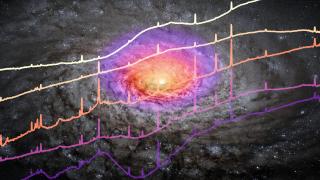Bibcode
Korsaga, Marie; Famaey, Benoit; Freundlich, Jonathan; Posti, Lorenzo; Ibata, Rodrigo; Boily, Christian; Kraljic, Katarina; Esparza-Arredondo, D.; Ramos Almeida, C.; Koulidiati, Jean
Bibliographical reference
The Astrophysical Journal
Advertised on:
8
2023
Journal
Citations
7
Refereed citations
6
Description
Observed scaling relations in galaxies between baryons and dark matter global properties are key to shed light on the process of galaxy formation and on the nature of dark matter. Here, we study the scaling relation between the neutral hydrogen (H I) and dark matter mass in isolated rotationally supported disk galaxies at low redshift. We first show that state-of-the-art galaxy formation simulations predict that the H I-to-dark-halo mass ratio decreases with stellar mass for the most massive disk galaxies. We then infer dark matter halo masses from high-quality rotation curve data for isolated disk galaxies in the local Universe and report on the actual universality of the H I-to-dark halo mass ratio for these observed galaxies. This scaling relation holds for disks spanning a range of 4 orders of magnitude in stellar mass and 3 orders of magnitude in surface brightness. Accounting for the diversity of rotation curve shapes in our observational fits decreases the scatter of the H I-to-dark halo mass ratio while keeping it constant. This finding extends the previously reported discrepancy for the stellar-to-halo mass relation of massive disk galaxies within galaxy formation simulations to the realm of neutral atomic gas. Our result reveals that isolated galaxies with regularly rotating extended H I disks are surprisingly self-similar up to high masses, which hints at mass-independent self-regulation mechanisms that have yet to be fully understood.
Related projects

Nuclear Activity in Galaxies: a 3D Perspective from the Nucleus to the Outskirts
This project consists of two main research lines. First, the study of quasar-driven outflows in luminous and nearby obscured active galactic nuclei (AGN) and the impact that they have on their massive host galaxies (AGN feedback). To do so, we have been granted time with the Gran Telescopio CANARIAS (GTC) in the optical and near-infrared ranges
Cristina
Ramos Almeida